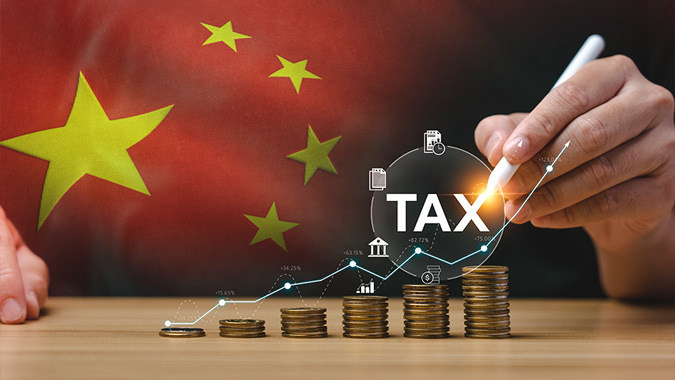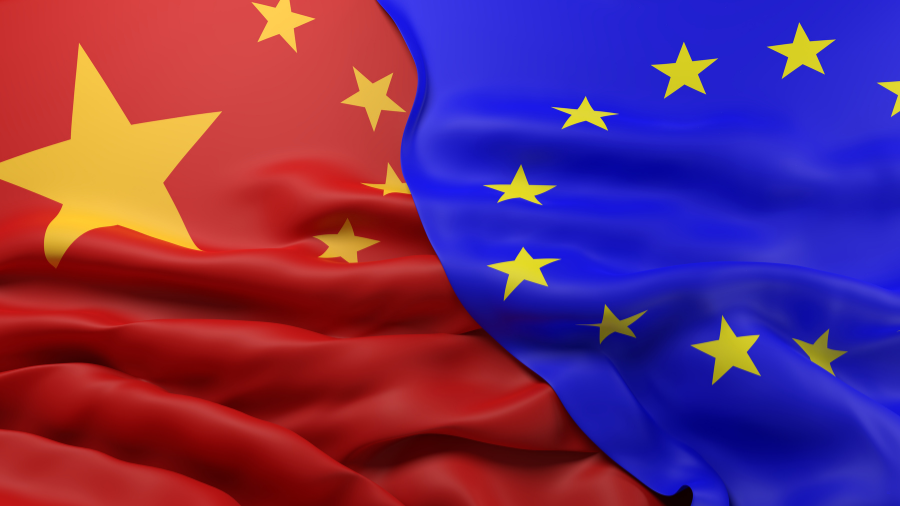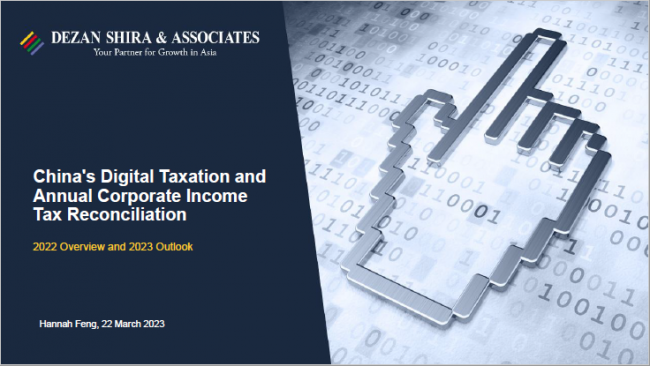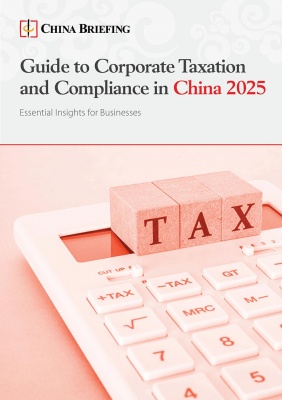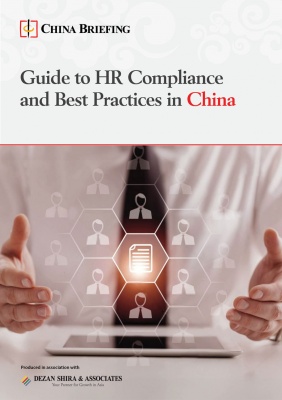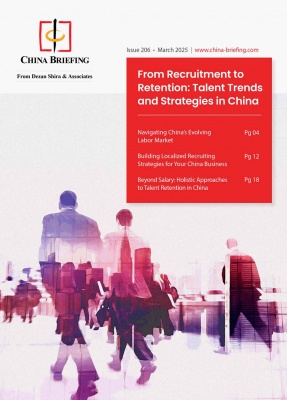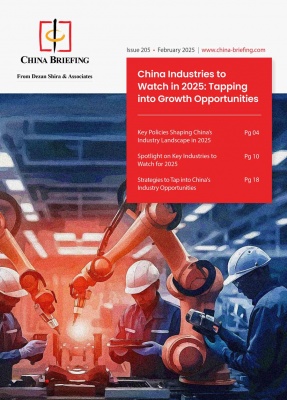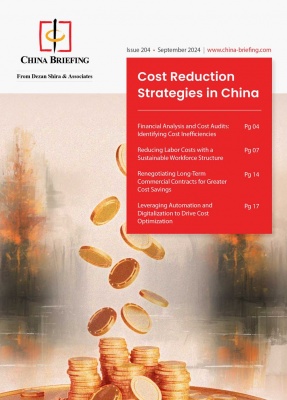Trump Raises Tariffs on China to 104% – Overview and Trade Implications
UPDATE (April 9, 2025): President Trump signed an executive order raising the reciprocal tariff rate on China from 34 percent to 84 percent, bringing the final rate to 104 percent. The additional 50 percent rate was implemented after China did not repeal the 34 percent duty it placed on US goods by April 8, as Trump had demanded. The 104 percent tariff, along with the reciprocal tariff rates placed on other countries, came into effect on Wednesday, April 9. In addition to the tariff hike, the executive order raised the de minimis duty rate on parcels valued under US$800 arriving from the Chinese mainland and Hong Kong to 90 percent, and the per-item fee to US$75 from May 1, rising to US$150 from June 1. The Chinese Foreign Ministry has thus far strongly condemned the latest move, calling it “economic bullying”, and vowed to “continue to the end” if the US continues its tariff war.
On April 2, 2025, President Donald Trump announced sweeping tariffs on global trade partners, citing a “national emergency” caused by unfair foreign trade practices. The new measures include a universal 10 percent “minimum base tariff” on all imported goods – fulfilling one of his key campaign promises – along with higher reciprocal tariffs targeting the US’s largest trading partners.
China faces one of the steepest tariffs, with Trump imposing an additional 34 percent duty. This is on top of the existing 20 percent tariff introduced in two rounds earlier this year, bringing the total tariff rate on Chinese goods to 54 percent.
The universal 10 percent tariff will take effect on April 5, while the additional 34 percent tariff on China, along with similar tariffs on other trade partners, will be implemented on April 9.
Trump has framed the 34 percent tariff as a “discounted rate,” claiming it is half of the 67 percent rate that his administration alleges China “charges” the US.
The 54 percent tariff is the latest in an escalating series of trade measures taken by the Trump administration against major trade partners, including tariffs on global steel, aluminum, and automobiles imports.
More tariffs are expected in the near future. A senior administration official told Reuters that additional duties are being considered on semiconductors, pharmaceuticals, and possibly critical minerals.
Timeline of US-China tariffs under Trump’s second term
January 20 – Trump signs America First Trade Policy:
- Calls for investigation into the US’s annual trade deficits in goods and recommending measures such as a global supplemental tariff
February 1 – Trump signs executive order slapping 10% tariff on Chinese imports:
- An additional 10% tariff is added to Chinese imports, ostensibly to curb the import of fentanyl and other illicit substances.
- Executive order also halts the de minimis exemption, which exempts parcels valued below US$800 from customs inspections and tariffs.
February 4 – 10% tariff on Chinese goods takes effect; China imposes tariffs on US imports and implements export controls on rare earths:
- A 15% tariff on American coal and liquefied natural gas.
- A 10% tariff on American crude oil, agricultural machinery, large-displacement cars, and pickup trucks.
- Export controls on 25 rare earth metal items, including critical materials for industries such as electronics, aerospace, and renewable energy.
February 7 – Trump pauses executive action ending de minimis exception
February 10 – Trump announces 25% tariff on steel and aluminum imports from all countries “without exception”; Chinese tariffs on American goods come into effect:
- 25% ad valorem tariff announced for all steel imports into the US.
- Tariffs on aluminum imports from 10% to 25%.
February 13 – Trump signs plan to impose reciprocal tariffs on all trade partners:
- The “Fair and Reciprocal Plan” will examine non-reciprocal trade relationships with all trade partners, including tariffs on US products; unfair, discriminatory, or extraterritorial taxes on US businesses, workers, and consumers; nontariff barriers or measures; and policies and practices that cause exchange rates to deviate from their market value.
February 21 – Trump signs a memorandum restricting Chinese investment in the US on national security grounds:
- Restricts China-affiliated investors from investing in technology, critical infrastructure, healthcare, agriculture, energy, raw materials, and other strategic sectors in the US.
March 3: Trump raises tariffs on Chinese goods to 20%, effective March 4.
March 4: China counters Trump’s tariff hike with duties on US agricultural products:
- A 15 percent tariff on chicken, wheat, corn, and cotton.
- A 10 percent tariff on sorghum, soybeans, pork, beef, aquatic products, fruits, vegetables, and dairy products.
March 26 – US Trade Representative Jamieson Greer holds video call with Chinese Vice Premier He Lifeng:
- Both sides voice interest in a trade agreement but provide no suggestion that negotiations have started.
- Trump suggests he may consider lowering tariffs on China in exchange for a deal over TikTok.
March 26 – Trump announces 25% tariff on worldwide imports of automobiles and parts:
- Tariff applies to imported passenger vehicles, light trucks, and key automobile parts, such as engines, transmissions, powertrain parts, and electrical components.
- Plan allows for processes to expand tariffs on additional parts.
April 2 – Trump imposes “reciprocal” tariff of 34% on China; reinstates end to de minimis exemption:
- Reciprocal traiff levied in addition to the existing 20% duty, raising the final rate to 54%.
- A minimum 10% universal tariff also announced for all goods entering the US.
- Ending of de minimis exemption for all parcels from Chinese mainland and Hong Kong valued under US$800, to be taxed at an ad valorem duty of 30% or US$25 per item from May 2, rising to US$50 per item from June 1.
April 3 – 25% tariff on automobiles takes effect.
April 4 – China retaliates with 34% tariff on US goods:
- Also implements export restrictions on 7 rare earth products and sanctions almost 30 American companies.
April 5 – 10% universal tariff takes effect.
April 8 – Trump raises reciprocal tariff rate on China to 84%.
- Also raises de minimis ad valorem duty to 90% and per-item fee to US$75 from May 1 (US$150 from June 1).
April 9 – Additional 84% tariff on China takes effect along with individual reciprocal tariffs on other trade partners:
- Final tariff rate on China reaches 104%.
April 10 – Chinese 34% tariff on US goods to take effect.
May 2 – De minimis exemption on parcels from Chinese mainland and Hong Kong to end.
54 percent tariffs on Chinese goods
The 54 percent tariff on Chinese imports follows a gradual escalation in duties levied on Chinese goods since Trump took office. In February and March, Trump raised the tariff rate on all Chinese goods to 20 percent, first implementing a 10 percent tariff, effective February 4, and then raising it by another 10 percent a month later.
Certain products will not be subject to the reciprocal tariffs, namely:
- Articles subject to 50 USC 1702(b), such as personal transfers of goods without value, donations, information or informational materials, and personal items transported during personal travel;
- Steel and aluminum articles and autos/auto parts already subject to Section 232 tariffs (meaning the rate on these products will remain at 25 percent);
- Copper, pharmaceuticals, semiconductors, and lumber articles;
- All articles that may become subject to future Section 232 tariffs;
- Bullion; and
- Energy and certain other minerals that are not available in the US.
The reciprocal tariffs were first announced on February 13, 2025, when he signed a memorandum directing key ministers to implement a plan to impose reciprocal tariffs on all trade partners. The “Fair and Reciprocal Plan” calls for examining non-reciprocal trade relationships with all global partners, including:
- Tariffs on US products;
- Unfair, discriminatory, or extraterritorial taxes on US businesses, workers, and consumers (including VAT);
- Nontariff barriers or measures, including subsidies and regulatory requirements; and
- Policies and practices that cause exchange rates to deviate from their market value.
According to WTO data, in 2023 (the latest available data), China’s simple average Most-Favored-Nation (MFN) applied tariff rate was 7.5 percent, with a trade-weighted average of 3 percent. In comparison, the US maintained a lower MFN applied rate of 3.3 percent and a trade-weighted average of 2.2 percent.
Breaking it down further, China’s MFN applied tariff rate in 2023 averaged 14 percent for agricultural products and 6.4 percent for non-agricultural products, while the US imposed lower rates of 5 percent and 3.1 percent, respectively.
| Most-Favored Nation Tariff Rates, US vs. China (2023) | ||
| US (%) | China (%) | |
| Simple average final bound
Total Agricultural Non-agricultural |
3.4 4.8 3.2 |
10 15.7 9.1 |
| MFN applied
Simple average Total Agricultural Non-agricultural Trade-weighted average Total Agricultural Non-agricultural |
3.3 5 3.1
2.2 4 2.1 |
7.5 14 6.4
3 13.1 2.2 |
| Binding coverage
Agricultural Non-agricultural |
100 100 |
100 100 |
| Source: World Trade Organization. | ||
China has also imposed various unilateral tariffs on US goods over the years, in addition to the ones levied in the last few months. On April 2, 2018, China implemented tariffs ranging from 15 to 25 percent on 128 US products worth US$3 billion, including fruit, wine, seamless steel pipes, pork and recycled aluminum in retaliation to the US’s steel and aluminum tariffs. Two days later, it again hit the US with 25 percent tariffs on US$50 billion worth of US goods, including automobiles, aircraft, beef, soybeans, whisky, and chemicals, in retaliation to the US’s imposition of tariffs on 1,333 types of Chinese products, also worth US$50 billion.
China has since granted exemptions for a variety of US goods, including agricultural products such as soybeans and pork, liquefied natural gas, crude oil, steel rails, certain medical equipment, and rare earth products, among others.
Besides higher tariff rates, the US has previously accused China of unfairly subsidizing the production of various goods to the detriment of the US’s domestic industries. China also imposes VAT on most goods and services, ranging from 6 to 13 percent, which the Trump administration could view as “unfair, discriminatory, or extraterritorial taxes on US businesses” and therefore are grounds for reciprocal action.
However, in his announcement on April 2, Trump claimed that China “charges” the US 67 percent, which serves as the rationale for imposing a “discounted” rate of 34 percent on China. The 67 percent figure appears to have been calculated by dividing the US’s trade deficit by its imports from China, when going by data from the USTR.
This suggests that the reciprocal tariffs are based more on the trade deficit China has with the US, rather than the effective tariff rate and other non-tariff barriers as stated in the plan. The official explanation from the USTR also states that calculations were made to reach “the tariff rates that would drive bilateral trade deficits to zero”. China would therefore potentially have to commit to reducing its trade surplus with the US by buying more American goods to reach a deal on reducing or eliminating the tariffs.
China’s countermeasures
Two days after Trump announced the recirpocal tariffs on China and the rest of the world, China retaliated with a 34 percent tariff on US imports. The announcement from the State Council Tariff Commission clarified that, while the 34 percent rate will apply in addition to other tariffs that are already levied, any current bonded and tax reduction and exemption policies will remain in place. The new tariff will take effect from April 10, 2025.
On the same day, China’s Ministry of Commerce (MOFCOM) and Customs Administrations placed export restrictions on seven different types of rare earths, namely various derivations of samarium, gadolinium, terbium, dysprosium, lutetium, scandium, and yttrium. A MOFCOM spokesperson stated that these items have “dual-use attributes”, and that the export controls are aimed at “better safeguarding national security and interests and fulfilling international obligations such as non-proliferation”.
MOFCOM also placed 16 American companies on the “export control list” and 11 American companies on the “unreliable entities list”.
The stated motive for this move is “to safeguard national security and interests and fulfill international obligations such as non-proliferation”. According to a statement from the MOFCOM spokesperson, the companies added to the unreliable entities list have “carried out so-called military and technical cooperation with Taiwan despite China’s strong opposition, seriously undermining China’s national sovereignty, security and development interests”.
Companies included on the export control list will be barred from purchasing certain goods and products from China, while the companies included on the unreliable entities list are prohibited from engaging in import and export activities related to China and may not make any new investments in China.
China has already retaliated to the two prior tariff hikes with import duties in kind. In response to the initial 10 percent tariff hike, China’s Customs Tariff Commission announced a 15 percent tariff on American coal and liquefied natural gas and a 10 percent tariff on American crude oil, agricultural machinery, large-displacement cars, and pickup trucks. On the same day, China’s Ministry of Commerce and Customs Administration announced export controls on 25 rare earth metal items, including various derivations of tungsten, tellurium, bismuth, and molybdenum, critical materials for industries such as electronics, aerospace, and renewable energy.
Following the second tariff hike, China’s Ministry of Finance announced a series of counter-tariffs on crucial US agricultural goods, imposing a 15 percent tariff on chicken, wheat, corn, and cotton, and a 10 percent tariff on sorghum, soybeans, pork, beef, aquatic products, fruits, vegetables, and dairy products. The targeting of US agricultural products is calculated, as China is one of the world’s largest importers of agricultural products and a major buyer of US soybeans, corn, and sorghum.
Impact on China trade
The imposition of a 54 percent tariff on Chinese goods is likely to have a significant impact on Chinese exporters, particularly small manufacturers of consumer goods that rely heavily on the US market. Many of these businesses, which produce lower-cost items such as electronics, clothing, toys, and other consumer goods, are vulnerable to the additional costs that the new tariffs impose. These companies may struggle to absorb the additional costs without compromising their competitiveness or profit margins. As a result, many will likely need to explore alternative consumer markets to maintain sales, but this could prove challenging, given the highly competitive nature of global markets and the logistical challenges of shifting production and distribution networks.
The US remains an important export market for China. In 2024, China exported US$524.66 billion in goods to the US, accounting for nearly 15 percent of its total exports, according to Customs data.
The tariff increase also threatens to spark inflationary pressures, both in the US and globally. Higher tariffs on Chinese goods will likely raise prices for US consumers, leading to a potential decrease in demand. As costs for American consumers rise, purchasing power will shrink, contributing to lower demand for goods not only from China but from other trading partners as well. In turn, this could slow global economic growth as consumer spending contracts.
Despite these challenges, Chinese exporters have the potential to shift their focus to other growing markets, such as Southeast Asia, Africa, and Latin America. These regions are seeing increasing demand for Chinese products, and while they may not yet match the scale or purchasing power of the US market, they present new avenues for growth. Chinese manufacturers may find opportunities to diversify their customer base, thus mitigating some of the negative impacts of US tariffs.
Meanwhile, the countertariffs placed on US goods by China will impede the US’s ability to sell more goods to China, thereby directly countering the desired impact of Trump’s reciprocal tariffs – to balance bilateral trade. However, the move is likely intended to give China better leverage in any potential trade negotiations, and to send a message to the US that it will not be bullied, rather than a desire to curb American imports.
The fallout from Trump’s tariffs on countries like Canada, Mexico, and those in the European Union could present an unexpected opportunity for China. As these countries face their own challenges in navigating Trump’s trade policies, they may look to strengthen trade relations with China. This could lead to a closer alignment between China and some of its smaller trade partners, as the restructuring of global trade may make it more advantageous for these nations to partner with China in certain areas, such as technology, manufacturing, and raw materials.
End to de minimis exemption
On April 2, the same day the US raised the tariff on China to 54 percent, Trump signed an executive order (EO) to once again end the de minimis exemption for parcels originating from the Chinese mainland and Hong Kong.
The de minimis exemption allows low-value packages – those worth under US$800 – to enter the US without customs duties or inspections. According to analysts, roughly four million packages per day entered the US under this exemption in 2024, many of them from Chinese e-commerce companies.
Trump had previously attempted to revoke the exemption as part of his February 1 tariff package but reversed the move within a week. On February 7, the White House issued an amendment delaying the change, following chaos at US logistics centers and customs warehouses. The US Postal Service had also temporarily suspended the acceptance of international parcels from the Chinese mainland and Hong Kong, but quickly reversed course.
The latest executive order claims that “adequate systems” are now in place to assess and collect duties on incoming parcels. As a result, the US will begin imposing duties on small-value packages from the Chinese mainland and Hong Kong starting May 2, 2025.
The Trump administration has justified the move by alleging that Chinese-based shippers use the de minimis channel to engage in deceptive shipping practices. The EO states that some Chinese exporters “hide illicit substances and conceal the true contents” of parcels, avoiding detection due to the limited screening associated with de minimis treatment. The White House has linked this to broader concerns about fentanyl trafficking, which it claims is facilitated in part through these small parcels.
Under the new rules, packages from mainland China and Hong Kong will be subject to the following duties:
- Ad valorem duty of 30 percent of the declared value of the postal item
- Specific duty:
- US$25 per item between May 2 and May 31, 2025
- US$50 per item beginning June 1, 2025
The EO also directs the Secretary of Commerce to make an assessment of the potential impact of the order on American consumers and businesses, and provide a recommendation on whether the end of the exemption should also be extended to Macau “to prevent circumvention of this order”.
Impact on China trade
The end of the de minimis exemption is expected to significantly disrupt the US e-commerce landscape, with ripple effects for consumers, global logistics networks, and the broader trade environment. Online platforms such as Shein, Temu, and Amazon, along with thousands of small and mid-sized US businesses that rely on low-cost Chinese imports, are particularly vulnerable.
Speaking to the Securities Times, Wang Xiaoyan, Deputy Director of the Henan International Digital Trade Research Institute, said that the end of the de minimis exemption represents a “precise blow” to China’s cross-border e-commerce model, and that the move “weakens the cost-effectiveness” advantage of Chinese exports.
Wang also noted that the US policy shift could act as a precedent for other governments, potentially triggering a wave of tighter regulations elsewhere. The EU, Thailand, Vietnam, and Singapore are reportedly considering similar policy adjustments, suggesting broader global scrutiny of low-value imports and efforts to curb China’s export-driven digital commerce model.
However, in the US, large platforms like Shein and Temu may be able to absorb some of the impact by adapting their operations. Speaking to the New York Times, Sheng Lu, an apparel business professor at the University of Delaware, explained that Shein’s model of rapid, small-batch production in China is not easily replicated elsewhere, and that “There’s no realistic alternative to make their products”.
Meanwhile, according to the New York Times report, both Shein and Temu have already been diversifying by partnering with US vendors and establishing warehouses in the US, which could mitigate some disruptions. Aaron Rubin, CEO of ShipHero, a warehouse management software company, emphasized that the EO will not destroy companies like Shein or Temu, rather, it will “change the business model”.
The end of the de minimis exemption is nonetheless expected to have a significant impact on smaller American businesses who rely on these cheap imports from China, and will find it difficult to pass on the costs to their price-sensitive consumers. Additionally, it is also expected to affect millions of US consumers, who will experience delivery delays, higher prices, or both.
25 percent steel and aluminum tariffs
On February 10, Trump signed proclamations restoring the 25 percent tariff on all steel imports (the “steel proclamation”) and raising the tariff on aluminum imports from 10 to 25 percent (the “aluminum proclamation”). The tariffs, which apply to imports from all countries and regions, took effect on March 12, 2025.
Trump first imposed tariffs on imports of steel and aluminum in 2018 following the release of the Section 232 Investigation, which found that steel and aluminum products were arriving in the US “in such quantities and under such circumstances as to threaten to impair the national security” of the country.
In 2018, Trump imposed tariffs on steel and aluminum imports after a Section 232 Investigation found that these imports threatened US national security. According to the steel proclamation, the 25 percent steel tariff initially reduced reliance on imports and boosted domestic consumption. However, due to exemptions and agreements made during both the Trump and Biden administrations, imported steel now makes up a similar portion of US consumption as before the tariffs.
Meanwhile, the aluminum declaration states that the 10 percent aluminum tariff was less effective, as efforts to bypass the tariff and various country exemptions led to a decline in domestic aluminum smelter capacity utilization, preventing the tariff from achieving its intended national security goals. Both proclamations highlight a global excess capacity crisis for steel and aluminum, with rising Chinese steel exports displacing production in other countries and leading to increased steel imports to the US.
The Biden administration had already raised the tariff on imports of Chinese steel and aluminum products to 25 percent in September 2024. This means that China’s steel and aluminum were already subject to a 25 percent tariff when entering the US before Trump imposed his new tariff regime. Moreover, the 10 percent tariff on aluminum coming from China has remained in place since 2018.
Impact on China trade
China currently exports relatively small amounts of steel and aluminum directly to the US, accounting for just 0.8 percent of China’s total steel exports in 2024.
However, the global nature of Trump’s steel and aluminum tariffs means that Chinese steel exports to other countries may be impacted. Major sources for US steel imports, such as Vietnam and Canada, accounted for 25.22 percent of China’s total steel exports in 2024, according to Investor.org.cn. As the tariffs are effective worldwide, they will indirectly affect Chinese steel re-exports to the US via these third countries, thereby significantly impacting China’s global steel exports and restructuring global industry chains.
Similarly, China’s aluminum exports to the US have already been declining for four consecutive years, making up just 8.2 percent of China’s total aluminum exports in 2024, according to Wuchan Zhongda Futures Research Institute. This decline is largely due to previous high US anti-dumping duties. As a result, the direct impact of Trump’s new aluminum tariffs on China’s exports is expected to be limited. However, a greater effect may come from potential disruptions in re-export trade through Mexico and Canada, where a significant share of Chinese aluminum exports currently flow.
China’s annual aluminum exports are about 5 million to 6 million tons, accounting for 12.85 percent of production. In 2023, Mexico was China’s largest export destination for aluminum, accounting for 9.6 percent of total aluminum exports, while the US and Canada accounted for 4.6 percent and 3.8 percent respectively. Aluminum exported to the North American Free Trade Zone accounted for 18 percent of China’s total aluminum exports.
According to Li Kui, a non-ferrous metals researcher at Huarong Rongda Futures, while the short-term impact of Trump’s tariff hike may be limited, in the medium to long term, it could negatively affect China’s aluminum export trade. China has historically faced anti-dumping duties ranging from 10 percent to 75 percent across various countries, leading to a 30 percent to 60 percent decline in exports. Trump’s new tariffs will raise the duties on some Chinese aluminum products from 7.5 percent to 25 percent, which could further deter direct shipments to the US while closing off indirect export routes through Mexico and Canada.
25 percent tariff on global auto imports
On March 26, Trump signed a proclamation imposing a 25 percent tariff on imported automobiles and certain auto parts, citing a “critical threat to US national security.” The tariffs officially took effect on April 3.
Revitalizing the once-thriving US automobile industry has been a key pillar of Trump’s economic agenda, closely tied to his promise to bring back manufacturing jobs. The proclamation highlights that in 1985, US factories produced 97 percent of the vehicles sold domestically. By contrast, in 2024, 50 percent of the 16 million vehicles purchased by Americans were imported, with only 25 percent of their content manufactured in the US.
Impact on China Trade
Although China is a leading global car producer and exporter, the US is not a primary market for Chinese vehicles. As a result, China is not the main target of this tariff, which is instead aimed at major US trading partners such as Mexico, Japan, South Korea, and Germany.
According to ITC Trade Map, China exported US$20.4 billion worth of vehicles and auto parts to the US in 2024, accounting for just 5.2 percent of total US auto imports by value. China’s top vehicle export destinations in 2024 included Russia, Mexico, the United Arab Emirates, and Brazil. Meanwhile, Western Europe and Southeast Asia were the largest markets for Chinese electric vehicles (EVs), with the UK and Belgium leading in Europe and Thailand leading in Asia.
US-China dialogue and possible trade negotiations
Trump’s escalation of tariffs on China and his generally confrontational stance toward global trade make a potential trade deal between the US and China in the near future seem unlikely. However, both sides have expressed the need to come to the negotiating table to resolve their ongoing trade tensions.
According to the White House fact sheet, the new tariffs will remain in place until Trump “determines that the threat posed by the trade deficit and underlying nonreciprocal treatment is satisfied, resolved, or mitigated.” This suggests that Trump may be willing to halt or defer the tariffs if a deal can be reached, similar to his actions with Mexico and Canada in February. However, given the size of the US’s trade deficit with China, it remains uncertain how much can be done to convince Trump that the “nonreciprocal” treatment has been sufficiently addressed.
A video call held on March 26 between US Trade Representative Jamieson Greer and Chinese Vice Premier He Lifeng suggested little progress on potential negotiations. Greer emphasized Trump’s commitment to a trade policy that strengthens domestic industry and ensures fair competition, while He conveyed China’s concerns over additional tariffs, particularly those related to fentanyl and the Section 301 investigation. Both sides agreed on the importance of maintaining stable economic relations, but no significant breakthroughs were made.
On March 23, Chinese Premier Li Qiang met with US Senator Steve Daines in Beijing during the annual China Development Forum. Li emphasized the importance of dialogue and cooperation, warning that escalating tensions would harm both countries’ economic and trade interests. This meeting, the first between Chinese and US officials since Trump took office, signals a desire for continued communication and collaboration, even amid growing trade disputes.
Trump also stated in early February that he had spoken to Xi Jinping, describing their relationship as very positive; however, the Chinese side has not confirmed these discussions.
It is unlikely that substantial progress will be made until there can be a face-to-face meeting between Trump and President Xi Jinping. Trump’s personal politics, including his respect for Xi and his susceptibility to flattery, suggest that a meeting could be pivotal in persuading him to reach an agreement.
The possibility of a trade deal between the US and China hinges on several factors. Previous trade agreements, such as the Phase One trade deal reached under Trump’s first term, have shown that both sides are capable of reaching agreements on specific issues, such as intellectual property protections, agricultural exports, and currency manipulation.
Trump has suggested he may consider lowering tariffs on China in exchange for a deal involving the Chinese-owned social media app TikTok, which is facing an April 5 deadline to be sold or face a potential US ban. This could provide a potential leverage point for negotiation and allow China to give Trump a “win”.
However, a more comprehensive deal would require significant concessions on both sides.
For a successful trade deal to materialize, China would likely need to address US concerns over nonreciprocal trade practices, such as the alleged forced technology transfers and unfair market access. On the other hand, the US would need to reduce its tariffs in exchange for concrete progress in these areas. Additionally, continued dialogue between the two nations, especially through direct meetings between Trump and Xi, could help break the deadlock and create an environment conducive to further negotiations. The tone of past trade deals suggests that personalized diplomacy and the willingness to reach mutually beneficial agreements will be key to advancing any future US-China trade resolution.
This article was originally published on April 3 and last updated on April 9.
About Us
China Briefing is one of five regional Asia Briefing publications, supported by Dezan Shira & Associates. For a complimentary subscription to China Briefing’s content products, please click here.
Dezan Shira & Associates assists foreign investors into China and has done so since 1992 through offices in Beijing, Tianjin, Dalian, Qingdao, Shanghai, Hangzhou, Ningbo, Suzhou, Guangzhou, Haikou, Zhongshan, Shenzhen, and Hong Kong. We also have offices in Vietnam, Indonesia, Singapore, United States, Germany, Italy, India, and Dubai (UAE) and partner firms assisting foreign investors in The Philippines, Malaysia, Thailand, Bangladesh, and Australia. For assistance in China, please contact the firm at china@dezshira.com or visit our website at www.dezshira.com.
- Previous Article EU-China Relations After the 2024 European Elections: A Timeline
- Next Article US-China Relations in the Trump 2.0 Era: A Timeline


